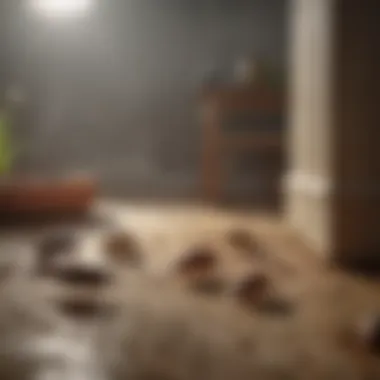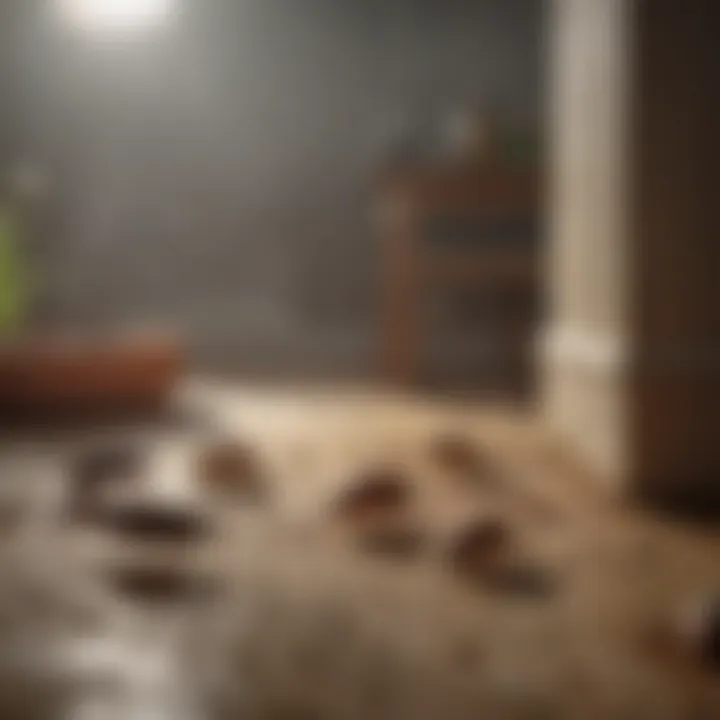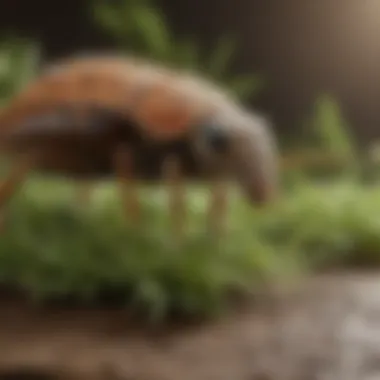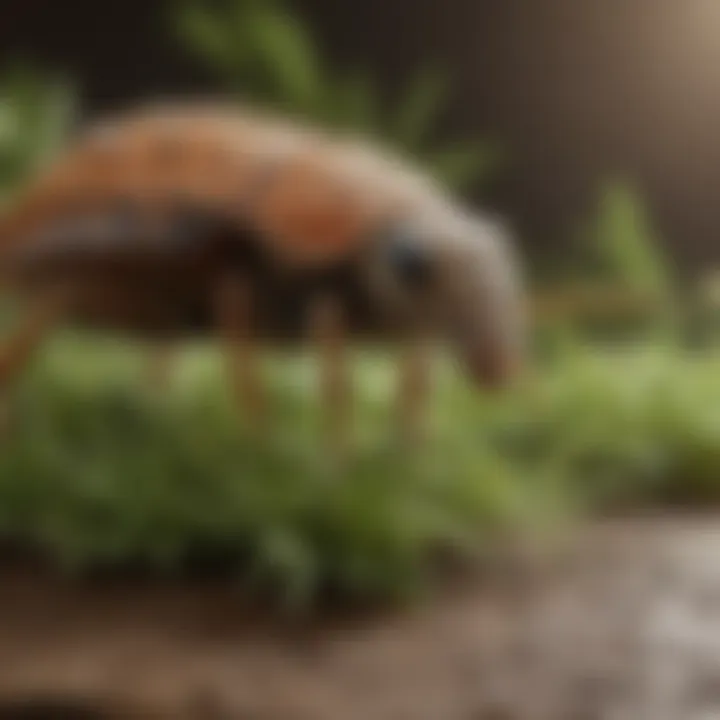Pest Away: A Comprehensive Guide to Pest Control


Intro
Pest control is a necessary aspect of maintaining a healthy environment, both inside and outside the home. As pests intrude on our spaces, they can cause damage, spread diseases, and disrupt the harmony we seek in our living areas. Understanding how to identify and manage these pests is key to effectively controlling them. This guide serves as a detailed resource, providing strategies that can help you deal with common pests in a responsible manner.
Understanding Pests
Definition of Pests
Pests are organisms that negatively affect human activities, causing harm to crops, animals, and even the home itself. They can include insects like ants, cockroaches, and termites, as well as rodents and weeds. Pests thrive in various environments and can reproduce rapidly, amplifying the damage they cause if left unchecked.
Importance of Pest Identification
Accurate identification of pests is crucial for effective control. Misidentifying a pest can lead to ineffective strategies that waste time and resources. Homeowners should know the typical signs of infestation, such as droppings, damage to plants, or nests. Identifying the specific pest can point to the best method for management, ensuring a tailored and effective approach.
Prevention Techniques
Home and Garden Preventative Measures
Preventing pest invasion begins at home and in the garden. Effective measures include:
- Sealing Entry Points: Inspect your home for cracks or openings that pests could use to enter. Use caulk or weather stripping to seal these gaps.
- Regular Cleaning: Keep areas clean and tidy. Pests are attracted to crumbs, spills, and garbage.
- Maintaining the Garden: Trim back bushes and trees. This reduces hiding places and keeps pests away from your home.
Seasonal Prevention Tips
Pest control is often seasonal. Adjusting your strategies according to the season can significantly reduce pest presence. For example:
- Spring: Inspect for early signs of ants and other insects emerging.
- Summer: Ensure that outdoor waste disposal areas are kept clean and monitored.
- Fall: Prepare your home for winter by sealing entry points; many pests seek shelter in colder months.
Eco-Friendly Pest Control Solutions
Overview of Sustainable Practices
Sustainable pest management focuses on minimizing harm to the environment while managing pest populations. Integrated Pest Management (IPM) is a widely appreciated approach which incorporates:
- Monitoring pest levels
- Using physical controls, like traps
- Applying chemical controls only when necessary, favoring less harmful options.
Natural Remedies and Their Effectiveness
Many homeowners look for natural solutions to pest problems. Here are several remedies:
- Diatomaceous Earth: This natural powder can deter many types of insects. It works by dehydrating them.
- Essential Oils: Oils like peppermint or lavender can repel spiders and other pests effectively.
- Vinegar Solutions: A mixture of vinegar and water can be effective in repelling ants and cleaning areas where pests frequent.
Effective pest management is not just about elimination; it's about creating an environment that discourages pests from entering your living spaces.
By understanding pests and employing prevention techniques and eco-friendly solutions, homeowners can successfully manage infestations. This guide aims to equip you with all necessary tools for effective pest control.
Understanding Pests
Understanding pests is fundamental to effective pest management. This section serves as the foundation for the entire guide, as it provides a clear and precise definition of what constitutes a pest. Knowing the different types of pests allows homeowners to effectively identify and address pest-related issues. This knowledge contributes to safeguarding health, economic stability, and overall well-being in residential environments.
Definition of Pests
Pests are organisms that negatively affect human activities, health, and property. They can cause damage to homes, crops, and gardens. Their presence often leads to economic loss and poses health risks. This definition helps to clarify why the control of pests is crucial. Recognizing pests in various forms—be it insects, rodents, or weeds—assists in developing targeted control strategies. This knowledge is not only beneficial for pest identification but also vital for implementing preventive measures.
Common Types of Pests
Common types of pests can be categorized into various groups. Each group presents distinct challenges and consequences that warrant understanding and management.
Insects
Insects are perhaps the most prevalent type of pest encountered in households and gardens. They include ants, cockroaches, and termites, among others. Insects often reproduce quickly, which means their populations can grow exponentially if not controlled. One key characteristic of insects is their adaptability to different environments, making them resilient. This rapid adaptability can be a disadvantage in pest control, as it requires continuous monitoring and management. However, certain insects also contribute to the ecosystem by pollinating plants or decomposing organic material, making a comprehensive understanding of their role important in pest management.
Rodents
Rodents, such as mice and rats, are another common category of pests. They are known for their ability to infiltrate homes through tiny openings and are often attracted to food sources. A significant aspect of rodents is their capacity to carry various diseases, which poses serious health risks to inhabitants. The key characteristic of rodents is their rapid reproduction, which can quickly lead to significant infestations. Controlling rodents requires not just removing the existing population but also preventing new ones from entering. Their presence also highlights the importance of sanitation and food storage in pest prevention strategies.
Weeds
Weeds are unwanted plants that can hinder the growth of desirable crops and vegetation. They often compete for nutrients, water, and light, causing significant problems for gardeners and farmers. One notable aspect of weeds is their resilience and ability to thrive in various conditions. This gives weeds an advantage in rapidly overtaking areas where desirable plants are growing. While they may not seem like a conventional pest, controlling weeds is essential for maintaining healthy gardens and landscapes. Understanding their life cycles and patterns can aid in devising effective management practices.
Fungi
Fungi can also act as pests, particularly to crops and plants. Common examples include mold and mildew, which can lead to plant diseases and decay. They thrive in damp, humid conditions, making moisture control important in pest management. The key characteristic of fungi is their ability to reproduce through spores, leading to quick spread. Managing fungal pests often requires different strategies than those used for insects or rodents. Recognizing the specific conditions that foster fungal growth allows for more effective prevention and control, protecting plants and food supplies.
The Importance of Pest Control
Pest control is essential for maintaining both health and economic stability. Pests can lead to significant damages in both residential and agricultural settings. Their presence can cause various consequences, affecting not only property but also the well-being of individuals. Understanding why pest control is crucial requires looking closely at its economic impact and the health risks associated with pests.
Economic Impact of Pests
The economic implications of pests can be substantial. Agriculture is one of the sectors most affected by pest infestations. According to recent studies, billions of dollars are lost every year due to pests damaging crops. This is not limited to farms; pests can infest homes and commercial spaces too.
- Property Damage: Termites and rodents can cause extensive structural damage to buildings, leading to costly repairs.
- Food Contamination: Various pests, such as mice and cockroaches, can contaminate food supplies, leading to health ordinances and disposal costs.
- Reduced Productivity: When pests infest areas where people work, productivity declines. Employees may be distracted by the presence of pests or even take sick days due to health complications that arise from pest-related issues.
- Loss of Revenue: Businesses that deal with food, such as restaurants and grocery stores, may lose customers if they are known for pest issues.
In sum, addressing pest problems promptly can lead to substantial financial savings. Investments in pest control should be viewed not as an expense but as an essential part of maintaining a healthy, productive environment.
Health Risks Associated with Pests
Pests pose numerous health risks that can directly impact individuals and communities. These risks can be both acute and chronic, depending on the type of pest and the scale of the infestation.
- Disease Transmission: Vector pests, such as mosquitoes and ticks, are well-known for transmitting diseases like West Nile virus, Lyme disease, and Zika virus. Efforts to control these pests are vital in preventing outbreaks.
- Allergic Reactions: Certain insects, particularly cockroaches and dust mites, can trigger allergies and asthma. In crowded areas, these rections may increase, impacting respiratory health.
- Food Safety: Pests can contaminate food supplies, leading to foodborne illnesses. For instance, rodent droppings in food storage areas pose a serious health threat.
- Mental Health: Living with an infestation can cause stress and anxiety, contributing to a negative quality of life. The emotional toll can be overlooked but is an important aspect of pest control.


Effective pest control is not just about eliminating pests, it is about safeguarding human health and wellbeing.
To summarize, the importance of pest control cannot be overstated. With proper understanding and management, the economic impacts and health risks can be significantly reduced. This ensures a safer and more productive living environment for everyone.
Identifying Common Pests
Identifying common pests is a vital aspect of effective pest control. Recognizing early signs of infestation can save time, money, and effort in managing pest-related issues. By accurately identifying the type of pest present, homeowners can select the most appropriate control methods, minimizing damage to property and health. This section will elaborate on key elements and benefits of pest identification.
Signs of Infestation
When dealing with pests, awareness of the signs of infestation is crucial. Pests can often be elusive, hiding away until their presence becomes a more significant problem. Key indicators include:
- Droppings: Finding fecal matter can often point towards the type of pest. For instance, rodent droppings are small and pellet-like, while insect droppings (frass) often resemble sawdust.
- Chewed Materials: Visible damage to food packaging, furniture, or even walls can signal pests like rodents or insects are present.
- Nesting: Finding nests made from materials such as paper, fabric, or natural debris is another sign, especially with animals like mice.
- Sounds: Unusual noises, particularly at night, may indicate rodents or other nocturnal pests.
Correctly identifying these signs allows for fast action, preventing further damage and potential health risks.
Pest Identification Techniques
To effectively manage pests, various identification techniques can be utilized. This ensures that the most appropriate control method is selected.
Visual Inspection
Visual inspection is one of the primary methods for identifying pests in any environment. Homeowners can conduct this by checking specific areas that are likely to harbor pests, such as:
- Kitchens and pantries: Look for droppings, food debris, or nesting.
- Basements and attics: These places often provide shelter for pests.
- Exterior areas: Inspect walls, foundations, and gardens for signs of pest activity.
The key aspect of visual inspection is its straightforwardness. Homeowners can easily assess their surroundings without needing specialized tools. This method is beneficial as it allows for quick evaluations and immediate reactions, making it a popular choice for pest identification. However, its disadvantage lies in the potential for overlooking pests that are very small or that blend into their environments.
Behavioral Observation
Behavioral observation focuses on monitoring pest activities over time. This technique may involve evaluating patterns such as:
- Feeding habits: Understanding what pests are consuming can give insights into their identity.
- Movement patterns: Noticing when and where pests are most active can aid in trap placement and prevention strategies.
Key characteristics of behavioral observation include depth of knowledge gained and ongoing monitoring capabilities. Its advantage is that it informs not just on current pest issues but also anticipates future problems. However, this method can be time-consuming and may require patience and consistency.
Incorporating both visual inspection and behavioral observation can yield a comprehensive understanding of pest activity, enhancing the effectiveness of management techniques.
Prevention Strategies
Prevention strategies play a vital role in effective pest management. Implementing such strategies not only reduces the likelihood of pest infestations but also minimizes the need for pest control interventions later. Focusing on prevention can save homeowners time, money, and resources. Moreover, it fosters a more sustainable approach to pest control because it seeks to address the environmental conditions that enable pests to thrive.
Behavioral Changes
One of the most effective prevention strategies involves making changes in daily habits. Simple behavioral modifications can significantly reduce pest attractants in homes. For instance:
- Proper Food Storage: Store food in airtight containers. This limits pest access to food sources.
- Regular Cleaning: Keeping a tidy environment is crucial. Regularly vacuuming and wiping surfaces can eliminate crumbs and spills, reducing the attraction for pests.
- Waste Management: Ensure garbage is disposed of safely and regularly. Use well-sealed bins to prevent rodents and insects from accessing waste products.
These changes create an environment less conducive to pests. Homeowners should recognize the influence of their daily actions on pest attraction.
Environmental Modifications
In addition to behavioral changes, environmental modifications are fundamental to pest prevention. This strategy involves altering the physical surroundings to deter pests. Essential steps include:
- Seal Entry Points: Inspect the home for cracks and gaps. Sealing these entry points can prevent pests like rodents and insects from entering.
- Remove Standing Water: Pests such as mosquitoes breed in stagnant water. Regularly check for and eliminate any sources of standing water, such as clogged gutters or over-watered plants.
- Landscape Management: Trim back excessive vegetation and keep plants healthy, as overgrowth can harbor pests. Maintaining a clean garden helps discourage pest infestation.
Implementing these practices can create a less inviting atmosphere for pests while promoting a healthier living environment. Both behavioral and environmental strategies are important in the overall pest management framework.
"An ounce of prevention is worth a pound of cure" – Benjamin Franklin. In pest control, this adage holds true as proactive measures can often avert larger problems later on.
Traditional Pest Control Methods
Traditional pest control methods have been a cornerstone in managing pests for centuries. They involve established techniques that use various interventions to alleviate pest problems effectively. Understanding these methods is crucial for homeowners seeking to create a pest-free environment in their homes and gardens. Traditional approaches not only aim to eliminate pests but also focus on the long-term management of these unwanted guests, helping to minimize the likelihood of their return. Furthermore, comprehending the benefits and limitations of these methods can assist in making informed choices regarding pest management strategies.
Chemical Pesticides
Chemical pesticides represent one of the most common traditional pest control methods. These substances are designed to kill or repel pests that threaten food sources or property. It is essential to recognize that while chemical pesticides can be effective, their use comes with specific considerations.
The advantages of using chemical pesticides include:
- Rapid Action: Many chemical pesticides act quickly to reduce pest populations.
- Wide Availability: Numerous options are available on the market, catering to various types of pests and infestations.
- Targeted Approaches: Certain pesticides are formulated to target specific pest profiles, enhancing effectiveness.
However, there are several important considerations:
- Health Risks: Exposure to chemical pesticides can pose health risks to humans and pets. Proper safety measures must be observed during application.
- Environmental Concerns: Runoff from applied pesticides can harm local ecosystems, affecting beneficial insects and plants.
- Resistance Issues: Over-reliance on chemical pesticides can lead to the development of resistant pest populations, making them harder to control in the future.
Homeowners should consider integrating safe practices when using chemical pesticides. It is advisable to always read labels before use, adhere to safety guidelines, and explore non-chemical alternatives when possible.
Traps and Baits
Traps and baits offer a more hands-on approach to pest control. Unlike chemical pesticides, which may involve widespread application of toxic substances, traps and baits allow for more controlled pest management. They are particularly effective for certain pests, such as rodents and insects.
The benefits of utilizing traps and baits include:
- Minimal Chemical Exposure: Many traps and baits do not contain harmful chemicals, reducing risks to humans and pets.
- Targeted Capture: These methods often target specific pests, making them effective for localized infestations rather than widespread issues.
- Easy to Monitor: Homeowners can easily assess the effectiveness of traps, adjusting their strategy based on observed results.
However, there are drawbacks to consider as well:
- Ongoing Maintenance: Traps and baits must be checked regularly and replenished as needed.
- Limited Scope: They may not be practical for large-scale infestations or for pests that are difficult to attract.
- Potential Non-Target Capture: There's a risk of capturing beneficial organisms if traps are not designed thoughtfully.
In summary, traditional pest control methods, including chemical pesticides and traps and baits, offer valuable tools for managing pest populations. Homeowners are encouraged to approach these methods thoughtfully, balancing effectiveness with environmental and health considerations. By combining these traditional methods with modern integrated pest management strategies, a comprehensive pest control plan can be established, ensuring a healthier living environment.
Eco-Friendly Pest Control Solutions


The emphasis on eco-friendly pest control solutions has grown significantly in recent years. As awareness of environmental issues rises, homeowners are looking for effective ways to manage pests without causing harm to their family, pets, and the planet. These solutions focus on using natural materials and methods that reduce chemical exposure and long-term environmental impacts. The relevance of discussing eco-friendly options lies not only in their effectiveness but also in their alignment with sustainable practices. By utilizing eco-friendly pest control solutions, individuals can contribute to environmental preservation while managing pest problems.
Biological Control
Biological control involves the use of natural predators or parasites to reduce pest populations. This method is often seen as a sustainable alternative to chemical pesticides. For instance, introducing ladybugs in gardens can be effective in controlling aphid populations.
The benefits of biological control include:
- Reduced chemical usage: This method often eliminates the need for harmful chemicals.
- Targeted action: Predators often target specific pests, minimizing collateral damage to beneficial insects.
- Long-term effectiveness: Once established, biological control agents can sustain themselves, providing ongoing pest management.
However, there are considerations. Introducing non-native species may disrupt local ecosystems. Therefore, it is vital to choose the right biological agents that are compatible with the existing environment.
Organic Pesticides
Organic pesticides are derived from natural sources, used as a pest management strategy that aligns with eco-friendly practices. These products often contain plant extracts or essential oils known for their insect-repelling properties. Common examples include neem oil and diatomaceous earth.
The advantages of using organic pesticides include:
- Safety for humans and pets: These products generally have lower toxicity levels compared to synthetic pesticides.
- Decomposability: Organic materials break down more quickly in the environment, reducing residue and pollution concerns.
- Versatility and efficacy: Many organic pesticides are effective against a wide range of pests while promoting a healthier ecosystem.
Certain challenges arise when using organic pesticides. They may require more frequent application and can be less effective in controlling large infestations. Therefore, it is essential for homeowners to regularly monitor their gardens and integrate organic pesticides into an overall pest management strategy.
Eco-friendly pest control solutions are essential for balancing pest management with environmental responsibility.
Integrated Pest Management (IPM)
Integrated Pest Management, commonly referred to as IPM, is a holistic approach to pest control that prioritizes prevention and the minimization of pest populations in a sustainable manner. It is crucial in understanding how to manage pest problems effectively. The focus of IPM is not merely on eradicating pests but on managing them within acceptable limits. This strategy incorporates a variety of techniques, each playing an essential role in maintaining ecological balance while protecting human interests.
Principles of IPM
The principles of IPM are foundational to its success. Firstly, IPM relies on monitoring pest populations and understanding their life cycles. This knowledge allows for informed decisions regarding control methods, targeting interventions when pests are most susceptible.
Secondly, it involves implementing a combination of cultural, biological, and physical control methods. These methods can include:
- Cultural Controls: Crop rotation, sanitation, and habitat management can reduce pest establishment.
- Biological Controls: Utilizing natural predators or parasites to control pest populations.
- Physical Controls: Barriers, traps, and traps to limit pest access.
Furthermore, chemical controls are applied only when necessary and ideally involve the use of less harmful products. This minimizes the risk to humans, pets, and the environment.
Implementation of IPM Strategies
Effective implementation of IPM strategies requires diligent planning and a systematic approach. Homeowners can begin by becoming familiar with the types of pests prevalent in their areas and the best practices to manage them. Regular monitoring is essential. This involves checking for signs of pest activity and understanding the damage they may cause.
Additionally, education plays a crucial role in the successful application of IPM. Homeowners should educate themselves about the lifecycle of specific pests as well as their natural habitats and breeding conditions. Knowledge allows for targeted intervention rather than broad-spectrum treatments that are often ineffective and harmful.
Homeowners can take these practical steps:
- Set Monitoring Schedules: Regularly inspect plants, soil, and structures for signs of pests.
- Use Threshold Levels: Determine the allowable level of pest presence before intervening.
- Mix Control Methods: Combine cultural, biological, and chemical methods in a thoughtful manner based on the assessment of pest activity.
Consider involving professionals when experiencing severe pest issues. A pest control specialist familiar with IPM can assist in creating a tailored strategy suited to your specific situation.
A well-implemented IPM strategy reduces the need for chemical treatments, promoting a healthier environment.
This approach aligns well with the common goals of homeowners who seek to maintain their living spaces while considering environmental impacts.
Challenges in Pest Control
Pest control trends constantly evolve. It is essential to understand the challenges that impact both professionals and homeowners. Awareness of these obstacles not only helps in implementing effective strategies but also encourages sustainable practices in pest management. Understanding this topic assists in recognizing the need for innovation and adaptability within pest control frameworks.
Resistance to Pesticides
Resistance to pesticides emerges as a significant challenge within pest management. Overuse of specific pesticides can lead to pest populations developing genetic resistance. This means that certain pests can survive treatments that previously killed them, leading to repeated applications and increased costs for homeowners.
Efforts to combat resistance include:
- Rotating pesticides: Using different classes of chemicals can reduce the likelihood of resistance.
- Integrating pest management (IPM): Utilizing multiple control strategies minimizes sole reliance on chemical treatments, hence reducing the chance of pests adapting.
Homeowners need to be aware of these developments. Many might not understand the implications of using the same product repeatedly. Such practices can create a cycle where efficiency declines, and toxic impacts on the environment increase.
Environmental Concerns
Environmental concerns represent another critical challenge in pest control. The application of various chemical pesticides raises serious issues about soil and water contamination. This situation affects not just immediate environments but broader ecosystems over time. Homeowners must be vigilant and consider eco-friendly alternatives that protect their health and environment.
Key environmental concerns include:
- Biodiversity loss: Pesticides can eliminate beneficial organisms, disrupting natural pest control mechanisms.
- Water quality: Runoff can transport chemicals to local water supplies, impacting aquatic life and drinking water sources.
- Soil health: Chemicals can alter the balance of microorganisms in the soil, affecting plant growth and health.
To mitigate environmental impact, adopting eco-friendly solutions is crucial. Organic pesticides or biological pest control methods can help minimize harm while maintaining effectiveness in managing pest populations.
"Integration of sustainable practices is vital in ensuring that current pest control methods do not compromise future generations' capabilities to manage pests."
Addressing Misconceptions About Pests
Misconceptions about pests can lead to ineffective management strategies. In this section, we explore common myths surrounding pests and the truth behind them. Understanding these misconceptions is vital for effective pest control and a healthier environment.
Understanding Pest Behavior
Many people perceive pests merely as nuisances. However, recognizing their behavior provides insight into their purposes and needs. For instance, insects like ants and bees play vital roles in ecosystems. Ants aerate soil, while bees facilitate plant pollination. This understanding can help homeowners appreciate these organisms' value.
A lack of knowledge can lead to mismanagement. Some believe all pests should be eradicated, disregarding their ecological functions. By learning about pest behavior, individuals can make informed decisions. They can control pests in ways that minimize harm to beneficial species. This balance is essential for maintaining a healthy ecosystem.
The Ecological Role of Insects
Insects are more than just pests; they contribute significantly to ecological health. Their roles include decomposition, pollination, and serving as food sources for other animals. Acknowledging this role is essential for informed pest control decisions. For example, ladybugs consume aphids. This natural predation benefits gardens and reduces the need for chemical interventions.


Not all insects are harmful. Many provide essential services that support plant growth and soil health. It is crucial to distinguish between harmful pests and beneficial insects. This distinction not only improves pest management strategies but also promotes biodiversity.
Understanding the ecological roles of pests helps residents manage their environments more sustainably.
In summary, addressing misconceptions about pests involves recognizing their behavior and ecological roles. This knowledge empowers homeowners to adopt strategies that benefit both their property and the environment. By understanding the integral part that pests play in our ecosystems, we can build a more harmonious coexistence.
Future Directions in Pest Control
The realm of pest control continuously evolves, driven by new challenges and improved understanding of pest behavior and ecology. This section aims to highlight the significant developments shaping the future of pest management. Homeowners and those interested in sustainable gardening will find this information particularly relevant. Emphasizing partnerships between technology and knowledge can lead to more effective pest control strategies.
Technological Innovations
Technological advances are reshaping how we approach pest control. Innovations such as smart traps equipped with sensors are becoming popular. These traps can detect pest activity and send alerts to homeowners, enabling timely action. Moreover, using drones for surveying infested areas is gaining traction. Drones can access hard-to-reach spaces, providing precise data on pest populations and behaviors, leading to targeted interventions.
Automatic identification of pests using artificial intelligence is also on rise. With smartphones, it is easier to snap a picture of a pest and receive immediate identification. This not only saves time but also ensures that the appropriate methods are applied effectively.
In addition, the development of precision agriculture tools allows for tailored pesticide application. Instead of blanket treatments, farmers can now apply chemicals only where necessary. This reduces the environmental impact and minimizes pesticide resistance, an ongoing challenge.
Research Trends in Entomology
Research trends in entomology are also critical in shaping future pest control. One significant area of focus is behavioral studies. Understanding how pests respond to various stimuli helps in developing strategies that exploit these behaviors. For example, attracting beneficial insects can naturally suppress pest populations.
Another trend is the exploration of genetic control methods. Scientists are investigating the potential of genetically-modifying pests, to reduce their reproduction rates. It is a complex topic, but it holds promise for sustainable pest management.
Research is also addressing the need for multi-disciplinary approaches. Combining insights from ecology, chemistry, and social sciences yields effective pest control strategies that align with environmental conservation efforts.
"The future of pest control blends technology and scientific understanding to promote efficient, eco-friendly practices."
In summary, the future directions in pest control look promising. With continued innovation and research, we can expect more efficient strategies that are not only effective at managing pests but also considerate of the environment.
Practical Steps for Homeowners
Effective pest control is a proactive endeavor that requires foresight and planning. Homeowners play a crucial role in maintaining a pest-free environment. By following practical steps, they can significantly reduce the likelihood of an infestation. The goal is not only to manage existing pests but to create conditions that deter them from entering the property. This section will elaborate on the importance of dedicated action towards pest control and the direct benefits it brings to households.
Creating a long-term pest control strategy has multiple advantages. First, it can save money by minimizing the need for expensive pest control services later. Second, it protects the health of the household. Many pests can carry diseases or allergens. Addressing potential pest problems early is essential for maintaining a healthy living space. Third, staying informed about pests can enhance one's understanding of home maintenance and safety.
Understanding the specifics of creating a pest control plan is foundational. Each home is unique, and thus, strategies must be tailored to fit particular circumstances.
Creating a Pest Control Plan
To effectively manage pests, every homeowner should develop a comprehensive pest control plan. This begins with knowledge and awareness about what pests are common in your area. Identifying the types of pests that may pose a risk can guide preventive actions.
Assess your home for vulnerabilities. Look for areas where pests might enter. This includes gaps around doors, windows, and utility lines. Seal these entry points to create a barrier.
Maintain cleanliness. Regularly clean food debris, crumbs, and spills as they attract various pests. Be diligent in waste disposal and ensure trash cans have tight-fitting lids. Keeping the home tidy is essential to stay pest-free.
Implement environmental modifications. This involves eliminating potential breeding grounds. Trim vegetation away from the house and ensure no stagnant water sits in your yard. Pests often thrive in dense foliage or standing water.
Establish monitoring. Keep track of any signs of pest activity, such as droppings or damage to plants. Understanding signs of an infestation early can help in devising a quick response.
When to Seek Professional Help
While self-management of pests can be effective, knowing when to seek professional assistance is equally important. There are instances when infestations become overwhelming, and specialized skills are necessary.
Consider professional help when:
- Infestations are widespread: If the number of pests exceeds control capabilities, professionals should be contacted.
- Health concerns arise: When pests pose direct health risks to family members, prompt intervention is critical.
- DIY methods fail: If repeated attempts to control pests have not yielded results, it may be time to consult experts.
Taking action now can prevent larger issues later. Managing pests effectively is a crucial responsibility for homeowners.
Choosing the right pest control service involves researching and verifying their credentials. Look for licensed, reputable companies with positive reviews. Also, understand the methods they employ to ensure they align with your values on environmental impact.
In summary, practical steps for homeowners encompass both preparation and responsive actions. Implementing a well-thought-out pest control plan can aid in avoiding infestations, while being aware of when to seek professional help ensures that serious issues are addressed correctly. By taking these decisive actions, homeowners can protect their living spaces more effectively.
Closure
The conclusion of this article plays a crucial role in summarizing the vast array of information covered regarding pest control. It is essential to underscore the significance of understanding pests and the challenges they pose in various environments, particularly for homeowners. When we consider pests, it is not merely about elimination; it involves a systematic approach to management and prevention.
In this article, we have discussed multiple facets of pest control that are relevant for the audience. One key aspect is the understanding of the economic impact that pests can have on homes and gardens. Homeowners must recognize not only the financial strain caused by pest infestations but also the potential health risks associated with these nuisances.
Another important point made is the emphasis on preventive strategies. By adopting preventative measures and embracing eco-friendly solutions, homeowners can safeguard their environments more effectively. This part of the conclusion highlights the benefits of being proactive rather than reactive, thus enhancing living spaces and reducing reliance on harsh chemical treatments.
Moreover, we touched upon Integrated Pest Management (IPM) as a holistic approach that illustrates how diverse techniques can be cohesive in managing pest issues. Understanding and applying these principles can significantly improve the outcomes of pest control efforts.
In summary, the conclusion reinforces that pest management is not a singular event or a matter of merely eradicating pests. Instead, it encompasses an ongoing commitment to monitoring, evaluating, and adjusting strategies as necessary. Emphasizing this will assist homeowners in creating sustainable practices, fostering a healthier environment for their families.
"Effective pest control is not just about the action taken today, but the foresight to prevent tomorrow's pests."
Equipped with this knowledge, homeowners can move forward with confidence, utilizing the comprehensive strategies presented in this article to tackle pest problems head-on. The intention is to empower individuals to take control of their environments and respond thoughtfully to the challenges posed by various pests.
Importance of Contacting Reliable Sources
Getting information from trusted sources is crucial when addressing pest issues. It ensures that the advice and methods you are using are accurate and backed by scientific research. Utilizing resources like academic journals or expert bodies ensures that homeowners and gardening enthusiasts have current and relevant information about pest control.
Specific Elements of References
- Credibility: References from established organizations or studies lend credibility to your pest control strategies. This is important to instill confidence in the methods you choose to tackle pest issues.
- Effectiveness: Higher-quality references often relate to proven methods. Choosing pest control solutions that have been validated through research can improve your chances of success.
- Updated Information: Pest control practices and technologies are constantly evolving. Thus, recent references can provide homeowners with the latest techniques and products that may not have been available previously.
Benefits of Citing References
- Informed Decision-Making: Proper references allow homeowners to make informed choices about pest control and prevention.
- Resourceful Learning: They encourage readers to delve deeper into particular pest management strategies. This can lead to broader knowledge and better application methods.
- Network of Information: From government sites to academic articles, having a list of credible references creates a network of information. Readers can readily explore these resources for further understanding.
Key Considerations
While references enhance the credibility of pest management practices, it is important to consider their relevance to your particular situation.
- Local Context: Some pest control methods may vary based on location. Ensure the references you consult are applicable to your geographic area.
- Target Audience: Different sources may cater to specific audiences. Always check if the information is suitable for the homeowner or the budding entomologist.
"The best pest control starts with solid information and reliable references."



